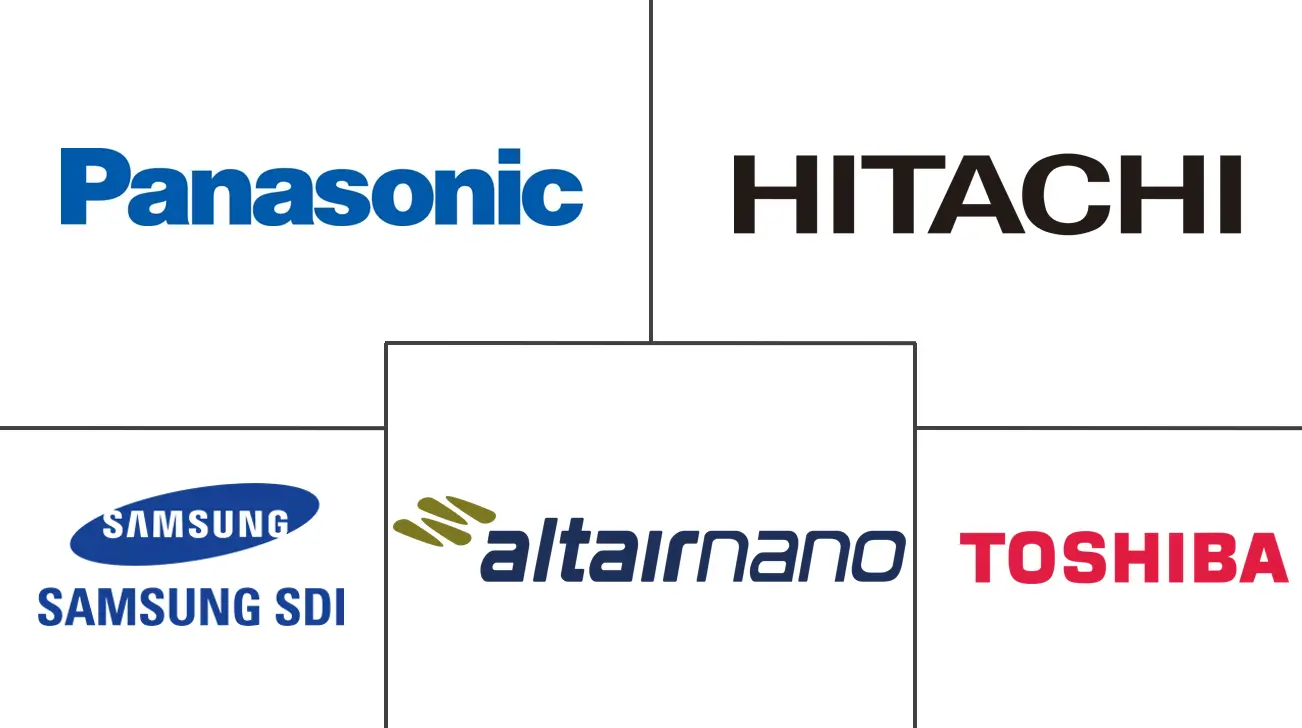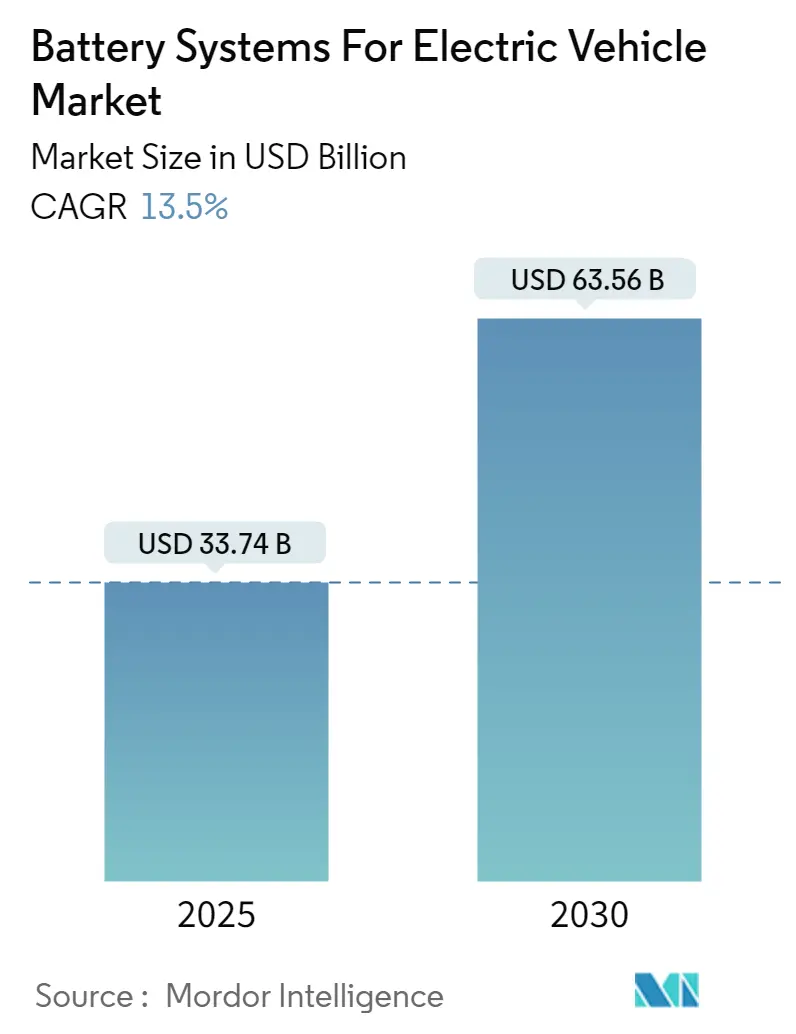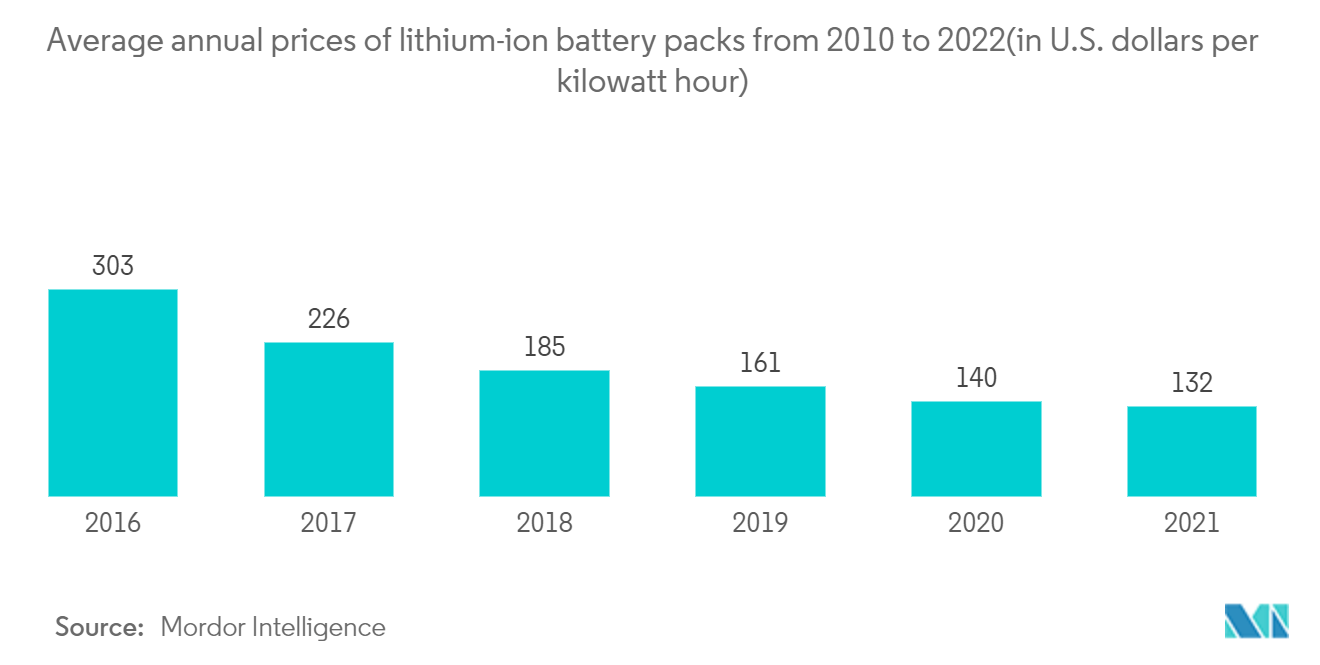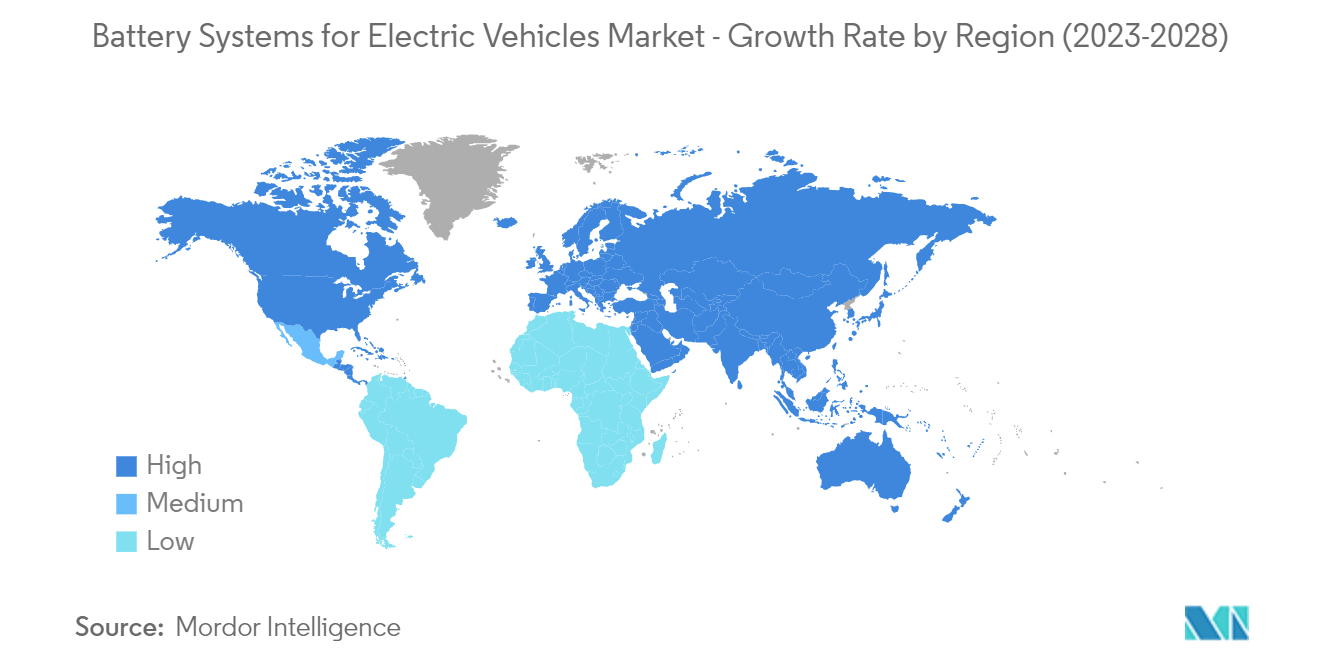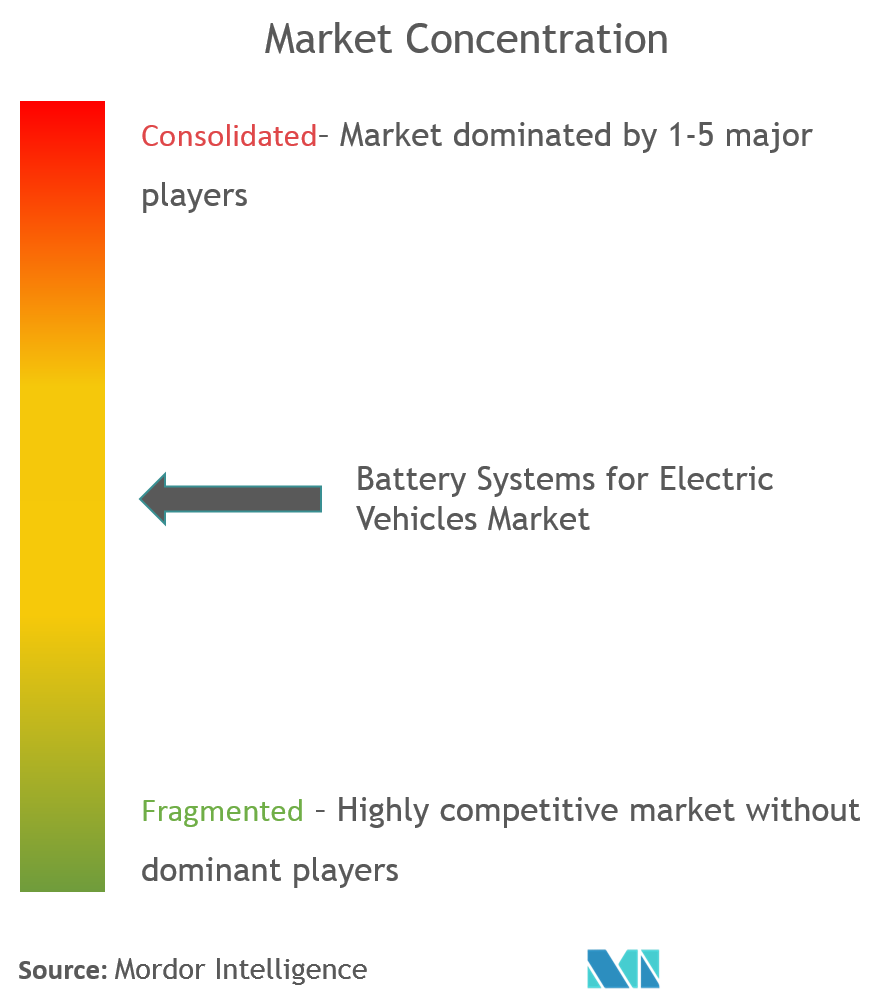Battery Systems for Electric Vehicles Market Analysis
The Battery Systems For Electric Vehicle Market size is estimated at USD 33.74 billion in 2025, and is expected to reach USD 63.56 billion by 2030, at a CAGR of 13.5% during the forecast period (2025-2030).
- The COVID-19 pandemic brought unprecedented challenges to the battery systems for the electric vehicles market. Lockdown measures and travel restrictions disrupted global supply chains, leading to delays and shortages in battery production. Manufacturing facilities and raw material supply chains were affected, impacting the availability and affordability of electric vehicles. Economic uncertainty, reduced consumer spending, and mobility restrictions resulted in a significant decline in electric vehicle sales. This decline directly impacted the battery systems market.
- The battery systems for electric vehicles market recovered and resumed its growth trajectory post-COVID due to several factors. Governments worldwide continue to prioritize decarbonization and sustainable transportation. Stimulus packages and supportive policies are likely to be implemented to boost the adoption of electric vehicles, which will drive the demand for battery systems.
- As the global economy recovers and restrictions ease, the demand for electric vehicles is expected to rebound. Consumers' increased focus on sustainability and environmental consciousness will contribute to the growth of the battery systems market. Continued research and development efforts will lead to advancements in battery technologies, including higher energy densities, faster charging capabilities, and longer ranges. These advancements will enhance the performance and attractiveness of electric vehicles, driving the demand for battery systems.
- Battery electric vehicles are powered by the electricity stored in the onboard battery. The onboard battery used in electric vehicles can be classified under one of the following three types: nickel metal hydride, lead-acid, and lithium-ion. The chemical energy stored in rechargeable battery packs installed in battery electric vehicles propels the electric motors and motor controllers.
- Major governments across developed countries, including China, the United States, and Japan, are investing in electric mobility, which is likely to provide significant growth opportunities for the battery system for electric vehicle market. Asia-Pacific and North America are likely to dominate the market during the forecast period.
Battery Systems for Electric Vehicles Market Trends
High Cost of Battery and Limited Driving Range Hindering the Market Growth
- Several factors, such as government subsidies and incentives, drive the global battery electric vehicles market. Governments in many countries have extended benefits in the form of financial incentives to the buyers of battery electric vehicles. The amount of these incentives usually depends on the size of the battery.
- For instance, the Sustainable Energy Authority of Ireland (SEAI) provides buyers of battery electric vehicles with grants of up to USD 5,400 and exempts them from vehicle registration tax. Despite the growth of the battery in the electric vehicles market, it is also curtailed by some serious challenges.
- The range and performance of the battery in electric vehicles are significant restraints for the market. The batteries are typically less powerful and have a limited range (60-100 miles per charge), and are considered suitable only for short-distance travel. The limited travel range of batteries of electric vehicles raises concerns among consumers that their vehicles may run out of charge/power before reaching their destination.
- Longer charging duration is another major challenge for the market. The lack of availability of supercharging stations adds to the woes associated with the use of batteries in an electric vehicle. The high cost of the battery in the electric vehicle also poses a threat to the growth of the battery market in particular and battery electric vehicles in general. For instance, the price per usable kilowatt-hour of a lithium-ion battery ranges from USD 500 to USD 650, and thus, makes up a large proportion of the vehicle's cost.
Asia-Pacific Market Growing at a Faster Pace
The Asia-Pacific region is indeed experiencing rapid growth in the battery systems for electric vehicles market. Several factors contribute to the region's increasing prominence in this sector. Countries like China, Japan, and South Korea have witnessed a substantial increase in electric vehicle sales. These nations are actively promoting the adoption of electric vehicles through supportive policies, subsidies, and infrastructure development. The rising demand for electric vehicles in the Asia-Pacific region drives the need for advanced battery systems.
- For instance, In May 2023, Chinese automaker JAC Group and tech company HiNa Battery teamed up to create an electric car powered by a sodium-ion battery.
Additionally, Asia-Pacific has emerged as a major manufacturing hub for electric vehicles and their components. The region boasts a robust supply chain and a skilled workforce, making it an attractive destination for battery system manufacturers. This localized manufacturing reduces production costs and allows for efficient distribution. The Asia-Pacific region is home to several innovative battery technology companies and research institutes. These entities are dedicated to developing advanced battery systems with higher energy density, improved safety, and faster charging capabilities. The emphasis on research and development fosters innovation and positions the region at the forefront of battery system advancements.
Moreover, governments in the Asia-Pacific region have recognized the potential of electric vehicles and battery systems in achieving sustainable transportation goals. They provide financial incentives, subsidies, and grants to promote domestic battery manufacturing and research. These initiatives accelerate the growth of the battery systems market in the region. The Asia-Pacific region is investing in the development of charging infrastructure to support the growing number of electric vehicles on the roads. Governments, in collaboration with private players, are establishing charging stations and implementing smart grid solutions to address range anxiety and enhance the overall EV experience. This infrastructure development further propels the demand for battery systems.
Considering these factors, the Asia-Pacific region is expected to witness a faster pace of growth in the battery systems for electric vehicles market compared to other regions. It offers significant opportunities for battery manufacturers, suppliers, and related stakeholders to capitalize on the burgeoning electric vehicle market.
Battery Systems for Electric Vehicles Industry Overview
The key vendors include Samsung SDI Co Ltd, Toshiba Corporation, BYD, and Panasonic Corporation, as they will be responsible for providing the automobile makers with the battery kit shortly. Currently, the battery manufacturers of electric vehicles are investing in R&D to improve the chemistry of the batteries to give a longer discharge time.
Technological advances in Li-ion batteries have made them comparatively lightweight with a long lifespan compared to conventional lead-acid and valve-regulated lead-acid battery (VRLA) batteries. With battery electric vehicles becoming the most viable alternative to ICE-powered automobiles and a solution to the problem of emissions, the demand for this type of vehicle is expected to increase considerably during the forecasted period, which calls for an excellent opportunity for electric battery manufacturers.
For instance, Swiss start-up Morand has introduced a groundbreaking battery technology that significantly reduces the charging time of electric vehicles to approximately 72 seconds. Their innovative EV battery utilizes a hybrid system, cleverly combining conventional battery technology with ultracapacitor technology, aptly named eTechnology. This pioneering approach allows electric vehicles to achieve an impressive 80% charge in a mere 72 seconds and complete a full 100% charge in just 2.5 minutes.
Battery Systems for Electric Vehicles Market Leaders
-
Altairnano
-
Toshiba Corporation
-
Hitachi, Ltd.
-
Panasonic Corporation
-
Samsung SDI Co Ltd
- *Disclaimer: Major Players sorted in no particular order
Battery Systems for Electric Vehicles Market News
- March 2023: The US Department of Energy's Argonne National Laboratory announced the development of a revolutionary lithium-air battery system. This breakthrough technology has the potential to significantly increase the range of electric vehicles, paving the way for the replacement of traditional lithium-ion (Li-ion) batteries. The new design opens up possibilities for powering not just electric cars but also domestic airplanes and long-haul trucks.
- July 2022: Ford made significant strides in the electric vehicle market by expanding its battery chemistries and securing contracts to deliver an impressive 60 gigawatt hours (GWh) of annual battery capacity. This move is part of their strategy to achieve a global 600,000 electric vehicle production rate by late 2023.
- November 2021: Hitachi, Ltd., and UK bus operator First Bus entered into a strategic partnership agreement to drive their zero-emission agenda forward. Under this agreement, Hitachi Europe will provide a bus battery service and a charging infrastructure solution. This collaboration aims to promote their decarbonization program and advance the adoption of electric buses in the UK.
- October 2021: LG Group announced a substantial investment of KRW 15.1 trillion (about JPY 1.4345 trillion) in its battery business in South Korea by 2030. The investment will focus on strengthening domestic battery business bases as core R&D and production technology hubs. The goal is to accelerate the domestic production of battery materials, furthering LG's position in the battery market.
- October 2021: Stellantis, the automotive multinational, and Samsung SDI, the battery manufacturer, signed a memorandum of understanding to establish a joint venture. The purpose of this joint venture is to produce battery cells and modules specifically for North America. This collaboration is expected to boost the production and supply of batteries for electric vehicles in the region.
- October 2021: Panasonic showcased a more advanced prototype battery with an impressive five times the storage capacity of current batteries. This breakthrough innovation is expected to strengthen their partnership with U.S. EV-maker Tesla. The development holds the potential to significantly enhance the performance and range of Tesla's electric vehicles.
- September 2021: Toshiba Corporation, Sojitz Corporation, and Companhia Brasileira de Metalurgia e Mineração (CBMM, Brazil) announced their collaboration to commercialize next-generation lithium-ion batteries (LIBs) using niobium-titanium oxide (NTO). The three companies successfully completed the development of prototype cells and have decided to intensify their collaboration. The goal is to accelerate the development of mass production processes and bring these innovative batteries to market.
Battery Systems for Electric Vehicles Industry Segmentation
Battery system means a complete energy storage system, including the battery cell, battery module, battery management system, cell balance circuit, monitoring and sensing, thermal management system, safety management system, and physical integration and algorithms and source code related thereto.
The battery systems for electric vehicles market is segmented by type, vehicle type, and geography. By type, the market is segmented as lithium-ion, nickel-metal hydride batteries, lead-acid batteries, ultra-capacitors, and others. By vehicle type, the market is segmented as passenger cars and commercial vehicles. By geography, the market is segmented as North America, Europe, Asia-Pacific, South America, and Middle East, and Africa.
The report offers market size and forecasts for all the above segments in value (USD).
| Type | Lithium-Ion Batteries | ||
| Nickel-Metal Hydride Batteries | |||
| Lead-Acid Batteries | |||
| Ultra capacitors | |||
| Others | |||
| Vehicle Type | Passenger Cars | ||
| Commercial Vehicles | |||
| Geography | North America | United States | |
| Canada | |||
| Mexico | |||
| Rest of North America | |||
| Europe | Germany | ||
| United Kingdom | |||
| France | |||
| Italy | |||
| Rest of Europe | |||
| Asia-Pacific | China | ||
| Japan | |||
| India | |||
| Australia | |||
| Rest of Asia-Pacific | |||
| South America | Brazil | ||
| Argentina | |||
| Rest of South America | |||
| Middle-East and Africa | United Arab Emirates | ||
| Saudi Arabia | |||
| Rest of Middle-East and Africa | |||
Battery Systems for Electric Vehicles Market Research FAQs
How big is the Battery Systems For Electric Vehicle Market?
The Battery Systems For Electric Vehicle Market size is expected to reach USD 33.74 billion in 2025 and grow at a CAGR of 13.5% to reach USD 63.56 billion by 2030.
What is the current Battery Systems For Electric Vehicle Market size?
In 2025, the Battery Systems For Electric Vehicle Market size is expected to reach USD 33.74 billion.
Who are the key players in Battery Systems For Electric Vehicle Market?
Altairnano, Toshiba Corporation, Hitachi, Ltd., Panasonic Corporation and Samsung SDI Co Ltd are the major companies operating in the Battery Systems For Electric Vehicle Market.
Which is the fastest growing region in Battery Systems For Electric Vehicle Market?
Asia Pacific is estimated to grow at the highest CAGR over the forecast period (2025-2030).
Which region has the biggest share in Battery Systems For Electric Vehicle Market?
In 2025, the North America accounts for the largest market share in Battery Systems For Electric Vehicle Market.
What years does this Battery Systems For Electric Vehicle Market cover, and what was the market size in 2024?
In 2024, the Battery Systems For Electric Vehicle Market size was estimated at USD 29.19 billion. The report covers the Battery Systems For Electric Vehicle Market historical market size for years: 2019, 2020, 2021, 2022, 2023 and 2024. The report also forecasts the Battery Systems For Electric Vehicle Market size for years: 2025, 2026, 2027, 2028, 2029 and 2030.
Our Best Selling Reports
Battery Systems for Electric Vehicles Industry Report
Statistics for the 2025 Battery Systems For Electric Vehicle market share, size and revenue growth rate, created by Mordor Intelligence™ Industry Reports. Battery Systems For Electric Vehicle analysis includes a market forecast outlook for 2025 to 2030 and historical overview. Get a sample of this industry analysis as a free report PDF download.

